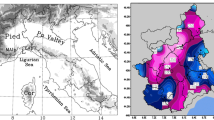Abstract
A mesoscale numerical weather prediction model has been developed at the U.K. Meteorological Office and is being tested as an operational short period forecasting tool. It has been constructed with a high degree of flexibility so that it can easily be used in other applications such as pollution dispersal modelling. It has a comprehensive suite of subgrid scale parametrizations modelling vertical turbulent transport, surface and cloud top radiation, surface exchanges, precipitation and penetrative convection. For routine use, a sophisticated initialisation scheme has been devised utilising inputs from its own previous forecast, a larger scale model, and surface synoptic observations. An important interactive analysis element has also been designed into this procedure. Results of cloud predictions are presented which show a useful level of skill.
Similar content being viewed by others
References
Barnes, R. T. H. and Golding, B. W. 1986 ‘A parametrization of deep convection for use in a non-hydrostatic mesoscale model’. Met. 0. 11 Tech NoteNo. 229. Meteorological Office, Met 0 11, Bracknell, England.
Carpenter, K. M. 1979 ‘An experimental forecast using a non-hydrostatic mesoscale model’. Quart.J.Roy.Met.Soc.105, 629–655.
Golding, B. W. 1987a ‘tShort range forecasting over the United Kingdom using a mesoscale forecasting system’. Submitted to J.Met.Soc.Japan.
Golding, B. W. 1987b ‘A strategy for using mesoscale data in an operational mesoscale model’. Met 0 11 Tech. NoteNo. 255 Meteorological Office, Met 0 11, Bracknell, England.
Heymsfield, A. J. 1977 ‘Precipitation development in stratiform ice clouds: a microphysical and dynamical study’. J.Atmos.Sci.34, 367–381.
Lind, R. J. and Katsaros, K. B. 1982 ‘A model of longwave irradiance for use with surface observations’. J.App.Met.21, 1015–1024.
Roach, W. J. and Slingo, A. 1979 ‘A high resolution infrared radiative transfer scheme to study the interaction of radiation with cloud’. Quart.J.Roy.Met.Soc. 105, 603–614.
Slingo, A. and Shrecker, H. M. 1982 ‘On the shortwave properties of stratiform water clouds’. Quart.J.Roy.Met.Soc.108, 407–426.
Smith, R. N. B. 1984a ‘The representation of boundary layer turbulence in the mesoscale model' Pt I The scheme without changes of state’ Met 0 11 Tech. NoteNo. 186. Meteorological Office, Met 0 11, Bracknell, England.
Smith, R. N. B. 1984b ‘The representation of boundary layer turbulence in the mesoscale model Pt II The scheme with changes of state’. Met 0 11 Tech. NoteNo. 187 Meteorological Office, Met 0 11, Bracknell, England.
Sommeria, G. and Deardorff, J. W. 1977 ‘Sub grid-scale condensation in models of non-precipitation clouds’. J.Atmos.Sci.34, 344–355.
Tapp, M. C. and White, P. W. 1976 ‘A non-hydrostatic mesoscale model’. Quart.J.Roy.Met.Soc.102, 277–296.
Author information
Authors and Affiliations
Rights and permissions
About this article
Cite this article
Golding, B.W. The U.K. Meteorological Office mesoscale model. Boundary-Layer Meteorol 41, 97–107 (1987). https://doi.org/10.1007/BF00120433
Issue Date:
DOI: https://doi.org/10.1007/BF00120433




